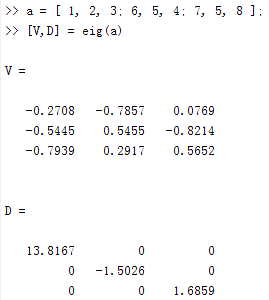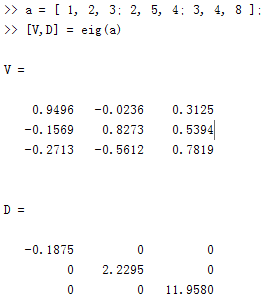(原)使用mkl计算特征值和特征向量
转载请注明出处:
http://www.cnblogs.com/darkknightzh/p/5585271.html
参考文档:mkl官方文档
lapack_int LAPACKE_sgeev(int matrix_layout, char jobvl, char jobvr, lapack_int n, float* a, lapack_int lda, float* wr, float* wi, float* vl, lapack_int ldvl, float* vr, lapack_int ldvr);
说明:
用于计算n*n实/复非对称矩阵A的特征值和左/右特征向量。
A的右特征值v满足:A*v = λ*v,λ为特征值。
A的左特征值u满足:${{u}^{H}}*A=\lambda *{{u}^{H}}$,λ为特征值。 ${{u}^{H}}$为u的共轭转置。The computed eigenvectors are normalized to have Euclidean norm equal to 1 and largest component real。
输入:
matrix_layout:数据存储格式,行优先- LAPACK_ROW_MAJOR,列优先- LAPACK_COL_MAJOR
jobvl:‘N’,不计算A的左特征值;‘V’,计算A的左特征值。
jobvr:‘N’,不计算A的右特征值;‘V’,计算A的右特征值。
n:矩阵A的阶数(n≥ 0).
a:(大小最小 max(1, lda*n)) ,包含n*n 的矩阵 A.
lda:数组a的leading dimension. 最小max(1, n).
ldvl, ldvr:输出数组vl、vr的leading dimensions
ldvl≥ 1; ldvr≥ 1.
If jobvl = 'V', ldvl≥ max(1, n);
If jobvr = 'V', ldvr≥ max(1, n).
输出:
a:该缓冲区会被覆盖
wr, wi:最小max (1, n) 的缓冲区。包含计算到的特征值的实部和虚部。
Complex conjugate pairs of eigenvalues appear consecutively with the eigenvalue having positive imaginary part first.
vl, vr:
vl (最小max(1, ldvl*n)) .
jobvl = 'N'时,vl不使用
计算到的特征值为实数时,对于第j个特征值:列优先时,第j个特征向量的第i个元素存储在vl[(i - 1) + (j - 1)*ldvl](每行存储对应的特征向量);行优先时,在vl[(i - 1)*ldvl + (j - 1)](每列存储对应的特征向量)。
计算到的特征值为复数及复矩阵的情况见官方文档。
jobvr = 'N'时,不使用vr
计算到的特征值为实数时,对于第j个特征值:列优先时,第j个特征向量的第i个元素存储在vr[(i - 1) + (j - 1)*ldvr](每行存储对应的特征向量);行优先时,在vr[(i - 1)*ldvr + (j - 1)](每列存储对应的特征向量)。
计算到的特征值为复数及复矩阵的情况见官方文档。
返回值:
0:计算成功
-i:第i个参数不合法
i:QR算法未能成功计算所有特征值,并且未计算任何特征向量。elements i+1:n of wr and wi (for real flavors) or w (for complex flavors) contain those eigenvalues which have converged.
lapack_int LAPACKE_ssyevd(int matrix_layout, char jobz, char uplo, lapack_int n, float* a, lapack_int lda, float* w);
说明:
计算实对称矩阵A所有特征值,(特征向量可选)。只计算特征值时,使用Pal-Walker-Kahan variant of the QL or QR算法。需要计算特征向量时,使用divide and conquer算法。
注意:
对于实对称问题,大部分情况下,默认的选择是syevr函数,该函数更快,并且内存使用更少。syevd函数需要更多内存,但是更快,特别是对于大矩阵。
输入:
matrix_layout:数据存储格式,行优先- LAPACK_ROW_MAJOR,列优先- LAPACK_COL_MAJOR
jobz:‘N’,只计算特征值;‘V’,计算特征值和特征向量。
uplo:‘U’,a存储了A的上三角部分;‘L’,a存储了A的下三角部分。
n:矩阵A的阶数(n≥ 0).
a:(大小max(1, lda*n)) ,包含实对称矩阵 A的上三角或下三角部分。通过参数uplo指定。
lda:数组a的leading dimension。最小max(1, n).
ldvl, ldvr:输出数组vl、vr的leading dimensions
ldvl≥ 1; ldvr≥ 1.
If jobvl = 'V', ldvl≥ max(1, n);
If jobvr = 'V', ldvr≥ max(1, n).
输出:
w:数组,至少max(1, n)。当返回值为0时,包含升序的特征值。
a:当jobz = 'V'时,该参数会被正交的特征向量覆盖。
返回值:
0:计算成功
-i:第i个参数不合法
i:jobz = 'N'时,算法未能收敛;i indicates the number of off-diagonal elements of an intermediate tridiagonal form which did not converge to zero;
jobz = 'V'时,the algorithm failed to compute an eigenvalue while working on the submatrix lying in rows and columns info/(n+1) through mod(info,n+1).
https://software.intel.com/en-us/articles/intel-mkl-111-release-notes
中写道:If LAPACKE_ssyevd fails to evaluate a matrix , workaround is to use LAPACKE_ssyev
lapack_int LAPACKE_ssyev(int matrix_layout, char jobz, char uplo, lapack_int n, float* a, lapack_int lda, float* w);
说明:
计算实对称矩阵A所有特征值,(特征向量可选)。
注意:
对于实对称问题,大部分情况下,默认的选择是syevr函数,该函数更快,并且内存使用更少。syevd函数需要更多内存,但是更快,特别是对于大矩阵。
输入:
matrix_layout:数据存储格式,行优先- LAPACK_ROW_MAJOR,列优先- LAPACK_COL_MAJOR
jobz:‘N’,只计算特征值;‘V’,计算特征值和特征向量。
uplo:‘U’,a存储了A的上三角部分;‘L’,a存储了A的下三角部分。
n:矩阵A的阶数(n≥ 0).
a:(大小max(1, lda*n)) ,包含实对称矩阵 A的上三角或下三角部分。通过参数uplo指定。
lda:数组a的leading dimension。最小max(1, n).
输出:
w:数组,至少max(1, n)。当返回值为0时,包含升序的特征值。
a:当jobz = 'V'时,如果info = 0,a中包含正交的特征向量。当jobz = 'N'时,包含对角线的下三角(uplo = 'L')或上三角(uplo = 'U')元素会被覆盖。
返回值:
0:计算成功
-i:第i个参数不合法
i:算法未能收敛。i indicates the number of elements of an intermediate tridiagonal form which did not converge to zero.
lapack_int LAPACKE_ssyevr(int matrix_layout, char jobz, char range, char uplo, lapack_int n, float* a, lapack_int lda, float vl, float vu, lapack_int il, lapack_int iu, float abstol, lapack_int* m, float* w, float* z, lapack_int ldz, lapack_int* isuppz);
说明:
计算实对称矩阵A所有特征值,(特征向量可选)。
可通过设定特征值的范围或者特征值的位置来选定特征值(Eigenvalues and eigenvectors can be selected by specifying either a range of values or a range of indices for the desired eigenvalues.)
输入:
matrix_layout:数据存储格式,行优先- LAPACK_ROW_MAJOR,列优先- LAPACK_COL_MAJOR
jobz:‘N’,只计算特征值;‘V’,计算特征值和特征向量。
range:'A',计算所有特征值;'V',计算vl < w[i]≤vu在半开区间的特征值;'I',计算索引从il到iu之内的特征值。
uplo:‘U’,a存储了A的上三角部分;‘L’,a存储了A的下三角部分。
n:矩阵A的阶数(n≥ 0).
a:(大小max(1, lda*n)) ,包含实对称矩阵 A的上三角或下三角部分。通过参数uplo指定。
lda:数组a的leading dimension。最小max(1, n).
vl, vu:range = 'V'时,计算到的特征值的左右边界(vl< vu);range = 'A'或'I',这两个参数不使用。
il, iu:当range = 'I'时,最小和最大特征值的索引。
n > 0时,1 ≤il≤iu≤n
n = 0时,il=1,iu=0
range = 'A'或'V'时,不使用这两个参数。
abstol:当jobz = 'V'时,the eigenvalues and eigenvectors output have residual norms bounded by abstol, and the dot products between different eigenvectors are bounded by abstol.
If abstol < n *eps*||T||, then n *eps*||T|| is used instead, where eps is the machine precision, and ||T|| is the 1-norm of the matrix T. The eigenvalues are computed to an accuracy of eps*||T|| irrespective of abstol.
ldz:输出缓冲区z的leading dimension。jobz = 'N'时,ldz≥ 1;jobz = 'V'时,列优先,ldz≥ max(1, n);行优先,ldz≥ max(1, m)
输出:
a:包含对角线的下三角(uplo = 'L')或上三角(uplo = 'U')元素会被覆盖。
m:总共找到的特征值数量,0 ≤m≤n。range = 'A'时,m = n;range = 'I'时,m = iu-il+1;range ='V'时,m未知(the exact value of m is not known in advance)
w:数组,至少max(1, n)。,包含升序的特征值,存储在w[0]w[m - 1]。
z:列优先时,大小max(1, ldz*m);行优先时,大小max(1, ldz*n)。jobz = 'V'时,如果返回值为0,z的前m列包含对应于特征值的正交的特征向量(with the i-th column of z holding the eigenvector associated with w[i - 1]);jobz = 'N'时,不使用z。
isuppz:数组,最小 2 *max(1, m)。The support of the eigenvectors in z, i.e., the indices indicating the nonzero elements in z. The i-th eigenvector is nonzero only in elements isuppz[2i - 2] through isuppz[2i - 1]. Referenced only if eigenvectors are needed (jobz = 'V') and all eigenvalues are needed, that is, range = 'A' or range = 'I' and il = 1 and iu = n.
返回值:
0:计算成功
-i:第i个参数不合法
i:发生了内部错误。
程序:
下面的程序将参数固定了,实际上可自行调整。
1 // 计算矩阵的特征值和特征向量 2 int SEigen(float* pEigVal, float* pEigVec, const float* pSrc, int dim) 3 { 4 float* eigValImag = new float[dim]; 5 float* eigVecVl = new float[dim * dim]; 6 float* pSrcBak = new float[dim * dim]; 7 memcpy(pSrcBak, pSrc, sizeof(float) * dim * dim); 8 9 int nRetVal = LAPACKE_sgeev(LAPACK_ROW_MAJOR, 'N', 'V', dim, pSrcBak, dim, 10 pEigVal, eigValImag, eigVecVl, dim, pEigVec, dim); // 计算特征值和特征向量 11 12 delete[] eigValImag; 13 eigValImag = nullptr; 14 delete[] eigVecVl; 15 eigVecVl = nullptr; 16 delete[] pSrcBak; 17 pSrcBak = nullptr; 18 19 return nRetVal; 20 } 21 22 // 计算实对称矩阵的特征值和特征向量 23 int SRealSymEigen1(float* pEigVal, float* pEigVec, const float* pSrc, int dim) 24 { 25 memcpy(pEigVec, pSrc, sizeof(float)* dim * dim); 26 return LAPACKE_ssyevd(LAPACK_ROW_MAJOR, 'V', 'U', dim, pEigVec, dim, pEigVal); // 计算特征值和特征向量 27 } 28 29 // 计算实对称矩阵的特征值和特征向量 30 int SRealSymEigen2(float* pEigVal, float* pEigVec, const float* pSrc, int dim) 31 { 32 memcpy(pEigVec, pSrc, sizeof(float)* dim * dim); 33 return LAPACKE_ssyev(LAPACK_ROW_MAJOR, 'V', 'U', dim, pEigVec, dim, pEigVal); // 计算特征值和特征向量 34 }
测试程序:
1 const int nDim = 3; 2 float pa[nDim * nDim] = { 1, 2, 3, 6, 5, 4, 7, 5, 8 }; 3 float eigVal[nDim]; 4 float eigVec[nDim * nDim]; 5 6 memset(eigVal, 0, sizeof(float)* nDim); 7 memset(eigVec, 0, sizeof(float)* nDim * nDim); 8 int ret1 = SEigen(eigVal, eigVec, pa, nDim); // 计算非对称矩阵的特征值和特征向量 9 10 memset(eigVal, 0, sizeof(float)* nDim); 11 memset(eigVec, 0, sizeof(float)* nDim * nDim); 12 int ret2 = SRealSymEigen1(eigVal, eigVec, pa, nDim); // 计算实对称矩阵的特征值和特征向量 13 14 int ret3 = SRealSymEigen2(eigVal, eigVec, pa, nDim); // 计算实对称矩阵的特征值和特征向量
SRealSymEigen1中LAPACKE_sgeev结果:
特征值:

特征向量:

matlab结果:

注意的是,C++中每列存储对应的特征向量。除了正负号之外,和matlab结果一致。
SrealSymEigen2中LAPACKE_ssyevd结果:
特征值:

特征向量:

matlab结果:

可见结果一致。
注意:测试程序中,pa并不是对称矩阵,但是使用SRealSymEigen1后,仍旧能得到正确的结果。说明,LAPACKE_ssyevd不会校验输入矩阵是否对称,直接按照输入要求,把对应的上三角或下三角作为A矩阵进行计算。
SrealSymEigen3中LAPACKE_ssyev结果:
特征值:

特征向量:

可见和LAPACKE_ssyevd特征值一样,特征向量在误差允许的范围内一致。
对于最后一个函数LAPACKE_ssyevr:
1 // 计算实对称矩阵的特征值和特征向量 2 int SRealSymEigen3() 3 { 4 const int nDim = 3; 5 float a[nDim * nDim] = { 1, 2, 3, 6, 5, 4, 7, 5, 8 }; 6 float eigVal[nDim]; 7 float eigVec[nDim * nDim]; 8 int isuppz[nDim * 2] = { 0 }; 9 int m = 0; 10 11 float aBakUp[nDim * nDim]; 12 memcpy(aBakUp, a, sizeof(float) * nDim * nDim); 13 14 memset(eigVal, 0, sizeof(float)* nDim); 15 memset(eigVec, 0, sizeof(float)* nDim * nDim); 16 LAPACKE_ssyevr(LAPACK_ROW_MAJOR, 'V', 'A', 'U', nDim, aBakUp, 17 nDim, -2, 5, 2, 3, 10, &m, eigVal, eigVec, nDim, isuppz); // step1 18 19 memcpy(aBakUp, a, sizeof(float)* nDim * nDim); 20 memset(eigVal, 0, sizeof(float)* nDim); 21 memset(eigVec, 0, sizeof(float)* nDim * nDim); 22 LAPACKE_ssyevr(LAPACK_ROW_MAJOR, 'V', 'V', 'U', nDim, aBakUp, 23 nDim, -2, 5, 2, 3, 10, &m, eigVal, eigVec, nDim, isuppz); // step2 24 25 memcpy(aBakUp, a, sizeof(float)* nDim * nDim); 26 memset(eigVal, 0, sizeof(float)* nDim); 27 memset(eigVec, 0, sizeof(float)* nDim * nDim); 28 LAPACKE_ssyevr(LAPACK_ROW_MAJOR, 'V', 'I', 'U', nDim, aBakUp, 29 nDim, -2, 5, 2, 3, 10, &m, eigVal, eigVec, nDim, isuppz); // step3 30 31 return 0; 32 }
执行完step1后:
特征值:

特征向量:

此时,所有特征值和特征向量都计算。
执行完step2后:
特征值:

特征向量:

此时,只筛选了符合要求的特征值(特征向量全部保存),但是特征值也不完全对应,不懂。
执行完step3后:
特征值:

特征向量:

此时,特征值和特征向量都不对应,更不懂了。。。
posted on 2016-06-14 19:39 darkknightzh 阅读(5329) 评论(0) 收藏 举报



 浙公网安备 33010602011771号
浙公网安备 33010602011771号